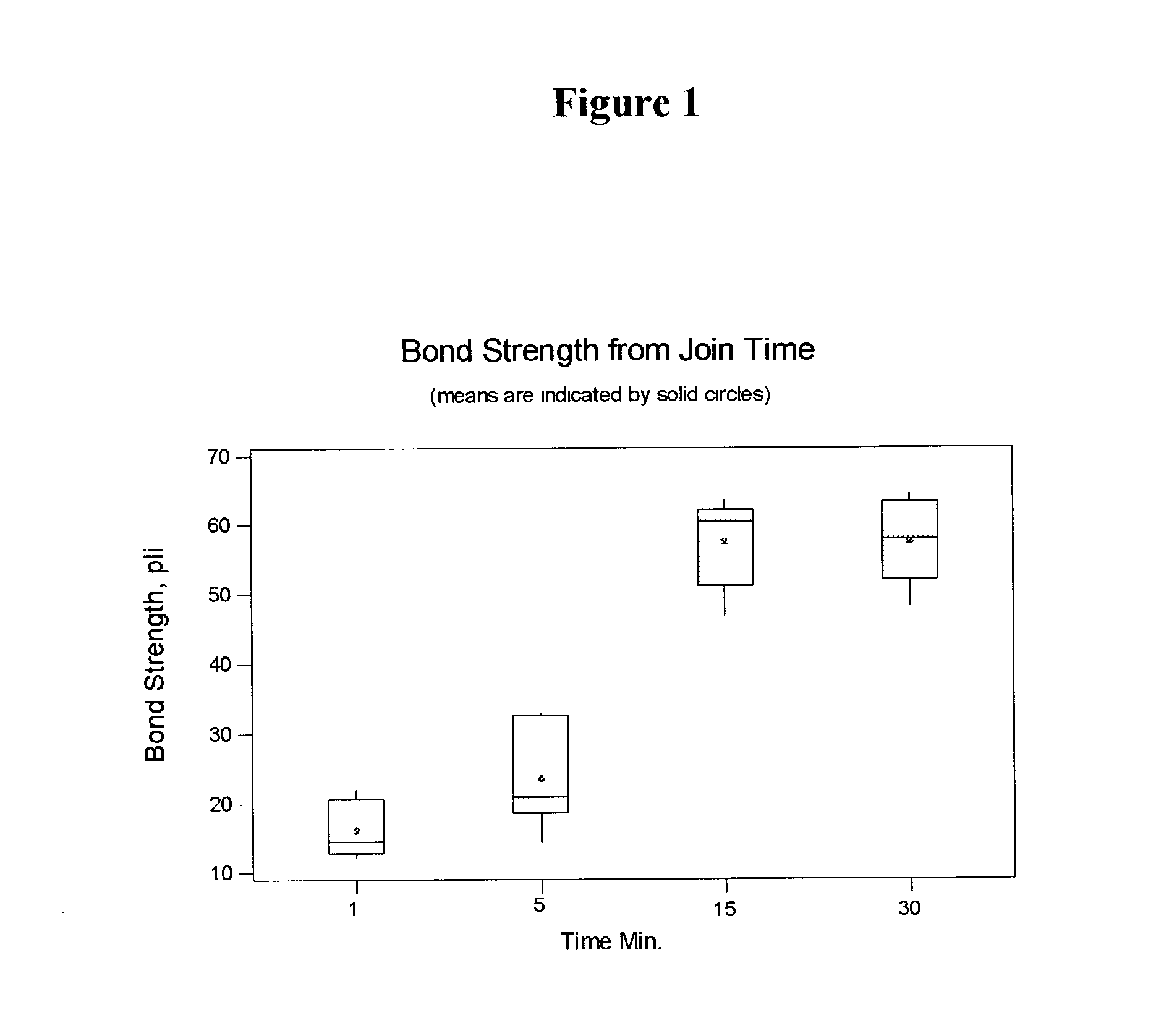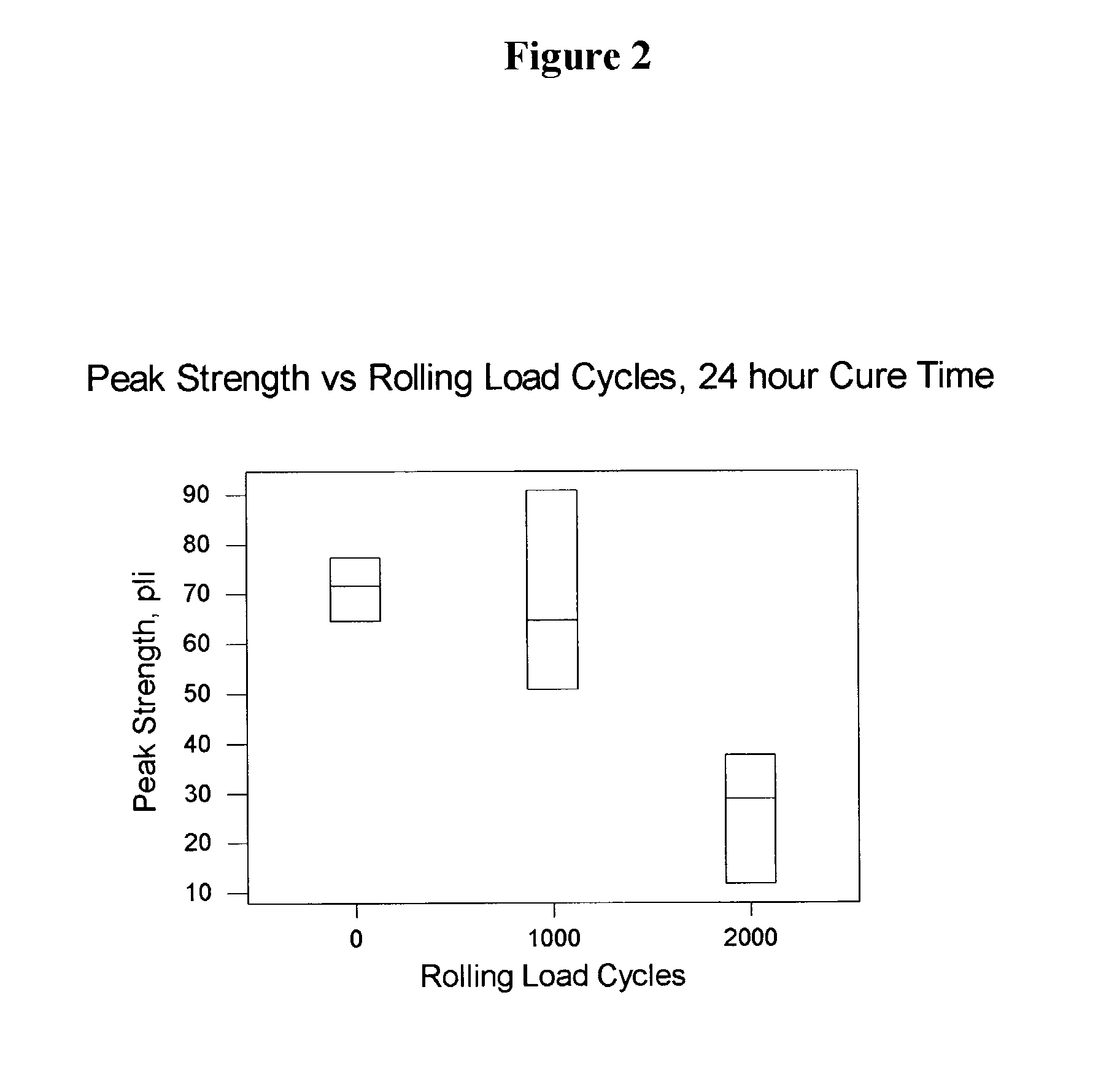Flooring with a 2-part adhesive
- Summary
- Abstract
- Description
- Claims
- Application Information
AI Technical Summary
Benefits of technology
Problems solved by technology
Method used
Image
Examples
example 1
[0055] Representative adhesive component parts A and B were prepared by mixing water with the ingredients shown in Tables 1 and 2. The polyvinyl alcohol used had a degree of hydrolysis of 72-76%. The defoamer was Dee Fo 215. AlCl.sub.3 was used as the crosslinking agent. Ingredients are shown in percent by dry weight.
1TABLE 1 First Adhesive Component Sample Sample Sample 1A 2A 3A Water 56.8 58.2 58.8 NMA-vinyl acetate 38 copolymer NMA-ethylene 35.6 vinyl acetate copolymer NMMA-vinyl 36 acetate copolymer PVOH 5 6 5 Defoamer 0.2 0.2 0.2
[0056]
2TABLE 2 Second Adhesive Component Sample 1B Sample 2B Water 58.8 60.8 Vinyl acetate 34 Homopolymer Ethylene vinyl 31 acetate copolymer PVOH 5 6 Defoamer 0.2 0.2 Crosslinking agent 2 2
[0057] The following tests as well as Examples 2-12 were conducted using the adhesives 1A and 1B described above. The laminate used in Examples 5-11 was Butterscotch Australian Cypress 24023 from Mannington.
[0058] The "standing water" test was conducted as follows:
[0...
example 2
[0074] Part-A adhesive (1A) was applied on the entire surface of the tongues of the engineered wood floor and laminate floor. Part-B (1B) of the adhesive which contains the crosslinker was applied on the entire surface of the grooves of the engineered wood floor (Mannington's Montana Oak Plank) and the laminate floor (Mannington's Traditional Collection). They were dried at ambient conditions for 3 days. Then both the tongue and groove were remoistened by spraying water. After that the floor panels were allowed to stand for 1 minute and then they were put together. After 24 hours, the bond strength and the seam swell of the flooring panels were tested.
8 Mannington Mannington Engineered Laminate Properties / Tests Wood Floor Floor Bond Strength (PLI) 84.7 .+-. 30.3 115.3 .+-. 17.9 % Weight gain after 24 hours 0.33 0.17 of wet sponge swell test % Seam Peaking after 24 hours 0.60 .+-. 0.39 2.92 .+-. 0.45 of wet sponge test
[0075] A damp or wet sponge is placed on the seam of the flooring ...
example 3
[0076] Part-A adhesive (1A) was applied on the entire surface of the tongue of the engineered wood floor (Mannington's Montana Oak Plank). Part-B (1B) of the adhesive which contains the crosslinker was applied on the entire surface of the groove of the engineered wood floor. In this example the effect of one coat vs. two coats were studied. After applying the adhesives they were dried at 120.degree. F. overnight. Then the bond strengths were tested.
9 Number of Coats Bond Strength (PLI) 1 35.9 .+-. 4.2 2 64.5 .+-. 5.1
[0077] Two coats result in a better bond strength. So the amount of adhesive applied can be optimized to have the desired bond strength.
PUM
| Property | Measurement | Unit |
|---|---|---|
| Fraction | aaaaa | aaaaa |
| Time | aaaaa | aaaaa |
| Temperature | aaaaa | aaaaa |
Abstract
Description
Claims
Application Information
 Login to View More
Login to View More - R&D
- Intellectual Property
- Life Sciences
- Materials
- Tech Scout
- Unparalleled Data Quality
- Higher Quality Content
- 60% Fewer Hallucinations
Browse by: Latest US Patents, China's latest patents, Technical Efficacy Thesaurus, Application Domain, Technology Topic, Popular Technical Reports.
© 2025 PatSnap. All rights reserved.Legal|Privacy policy|Modern Slavery Act Transparency Statement|Sitemap|About US| Contact US: help@patsnap.com


